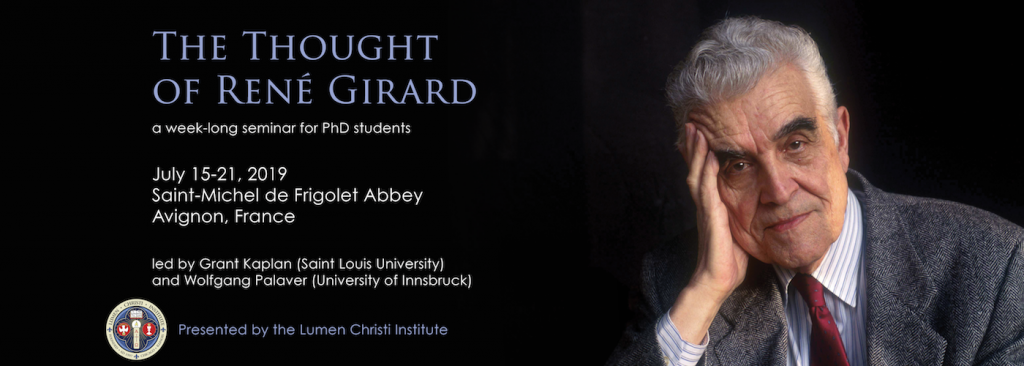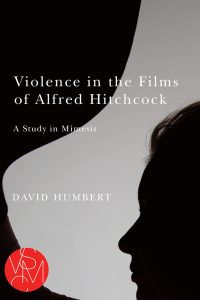
Contents
Letter from the President, Jeremiah Alberg
Editor’s Column, Curtis Gruenler
COV&R Annual Meeting 2019 at Innsbruck
COV&R Sessions at the American Academy of Religion
Theology and Peace Annual Conference
Jeremiah L. Alberg, ed., Apocalypse Deferred: Girard and Japan, reviewed by Matthew Packer
Letter from the President
Jeremiah Alberg
International Christian University
This is the quiet time of year, at least as President of the organization. The organizers of our annual meeting are getting busier and busier as the plans for the speakers and activities are getting settled. Here, at Headquarters (used in a purely metaphorical sense), we renewed our contract for Contagion with Michigan State University Press. This formalizes our move to digital subscriptions. Our application to Imitatio for support for the 2019 conference was approved. We have filed our taxes. All is right with the world.
I suspect that many of you also read with pleasure Robert Pogue Harrison’s review, “The Prophet of Envy,” in the December 20, 2018, issue of New York Review of Books. Harrison’s article was occasioned by the publication of Cynthia L. Haven’s biography of Girard, Evolution of Desire: A Life of René Girard. While doing justice to that work, Harrison took the opportunity to give an overview of Girard’s thought. His opening paragraph gives the reader a taste of how he handled the subject:
René Girard (1923–2015) was one of the last of that race of Titans who dominated the human sciences in the nineteenth and twentieth centuries with their grand, synthetic theories about history, society, psychology, and aesthetics. That race has since given way to a more cautious breed of “researchers” who prefer to look at things up close, to see their fine grain rather than their larger patterns. Yet the times certainly seem to attest to the enduring relevance of Girard’s thought to our social and political realities. Not only are his ideas about mimetic desire and human violence as far-reaching as Marx’s theories of political economy or Freud’s claims about the Oedipus complex, but the explosion of social media, the resurgence of populism, and the increasing virulence of reciprocal violence all suggest that the contemporary world is becoming more and more recognizably “Girardian” in its behavior.
The work that most of us do is relatively hidden. It is wonderful to see the public recognition accorded to Girard’s work and to works about him. These more visible events are the fruit of less visible efforts by a whole variety of people—the direct efforts of the authors and editors, the organizers and the publicists, but these people too rely on many others who remain unsung. The role of COV&R in sustaining and passing on “René Girard’s model of the relationship between violence and religion in the genesis of and maintenance of culture” is both immense and yet humble.
Without the sustenance and handing on, the insights can be lost. Their fruitfulness depends upon their being nurtured and tended to. In these times of scandal and stress let us continue the work we do.
Editor’s Column
Curtis Gruenler
Hope College

As mentioned above in the President’s Report, Contagion, COV&R’s annual academic journal, will now be published electronically. The next issue, volume 26, is scheduled to be published in May. Members will receive information by email when it is published about how to access it. Back issues are currently available on JSTOR and Project Muse, both of which many libraries subscribe to.
Members should receive two books some time this spring from Michigan State University Press: Reflection in the Waves: The Interdividual Observer in a Quantum Mechanical World by Pablo Bandera (from the series Breakthroughs in Mimetic Theory), and Shakespearean Cultures: Latin America and the Challenges of Mimesis in Non-Hegemonic Circumstances by João Cezar de Castro Rocha (from the series Studies in Violence, Mimesis & Culture).
The Bibliographies of the Literature on the Mimetic Theory that have been published in the Bulletin over the years are in the process of being incorporated into a new, searchable, online bibliography hosted by the University of Tübingen. Meanwhile, volumes 1-39 are available here, and volumes 40-45 are available on the COV&R website. Expect a new volume in our May issue. Thanks to Dietmar Regensburger for his work on the bibliography.
Forthcoming Events
2019 Annual Meeting
Innsbruck, Austria, July 10-13, 2019
“Imagining the Other:
Theo-political Challenges in an Age of Migration”

Complete information, including the call for papers and details about travel and accommodations, are now available on the conference website. Proposals for papers, panels, sessions, and seminars should be sent to cov-r2019@uibk.ac.at by April 30.
The opening lecture will be given by Peter Balleis SJ, who was director of the Jesuit Refugee Service from 2007 to 2014. Further updates about plenary speakers and conference registration will be posted on the conference website.
COV&R 2019 will coincide with the 350th jubilee of the University of Innsbruck, western Austria’s largest institution of research, with 28,000 students and 4,500 staff. Innsbruck is a city of 132,000 located at an elevation of 574 meters (1,722 feet) in the Inn River valley surrounded by mountains of the Tyrolian Alps extending up to 2,300 meters (7,000 feet) that can be reached by a cable car.
The Thought of René Girard
Avignon, France, July 15-21, 2019

Grant Kaplan and Wolfgang Palaver will lead a seminar open to Ph.D. students in the humanities and relevant fields, sponsored by the Lumen Christi Institute. Application materials are due March 1. Complete information is available here.
COV&R at the American Academy of Religion
San Diego, California, Nov. 23-26, 2019

COV&R will continue to function as a “related scholarly organization” at the Academy of Religion and Society of Biblical Literature, the largest annual meeting of scholars of religion in North America
The call for papers is open. You may propose a paper or a panel. In the past, COV&R has often held panels on a book, either a monograph or a collection of essays. The liaison for COV&R at the AAR is Grant Kaplan. Please send any questions and proposals (no more than 300 words is necessary for a paper, 500 for a proposal) to Grant Kaplan. Proposals are due May 1. We hope to see you in sunny San Diego in 2019.
Theology and Peace 12th Annual Conference
Nashville, Tennessee, June 17-20, 2019

COV&R affiliate Theology and Peace will return to American Baptist College for a conference on the theme “Beloved Community as the Way from Scapegoating to Ubuntu.” See their website for further information. Speakers will include Naomi Tutu, Michael Battle, Sandor Goodhart, Thee Smith, Janet Wolf, James Warren, and James Alison.
Book Reviews
For inquiries about writing a book review or submitting a book for review,
contact the book review editor, Matthew Packer.
Exemplary Japan
Matthew Packer
Buena Vista University
Jeremiah L. Alberg, ed., Apocalypse Deferred: Girard and Japan. Notre Dame, Indiana: University of Notre Dame Press, 2017. Pages x + 274.
 Here is a timely and superb collection of essays, a book suggesting even a new field for mimetic studies. Gathered mostly from the joint COV&R and Generative Anthropology meeting held in Tokyo in 2012, these are brilliant papers by leading Western and Japanese scholars of mimetic theory (MT) and GA, covering everything from the atomic bombings and biblical typology to Japanese folklore, film, anime, and manga. As one of the first major reckonings with René Girard’s apocalyptic-themed Battling to the End, conducted in the context of Japan’s own apocalyptic experience, the conference itself was timely. Collectively, too, the papers are urgent, especially given today’s renewed nuclear arms race. In light of Girard’s urging (in Battling) that we need “mimetic history,” of the sort pointed to in Apocalypse Deferred, since it would help us understand “what is at stake in our own time,” this volume is essential reading.
Here is a timely and superb collection of essays, a book suggesting even a new field for mimetic studies. Gathered mostly from the joint COV&R and Generative Anthropology meeting held in Tokyo in 2012, these are brilliant papers by leading Western and Japanese scholars of mimetic theory (MT) and GA, covering everything from the atomic bombings and biblical typology to Japanese folklore, film, anime, and manga. As one of the first major reckonings with René Girard’s apocalyptic-themed Battling to the End, conducted in the context of Japan’s own apocalyptic experience, the conference itself was timely. Collectively, too, the papers are urgent, especially given today’s renewed nuclear arms race. In light of Girard’s urging (in Battling) that we need “mimetic history,” of the sort pointed to in Apocalypse Deferred, since it would help us understand “what is at stake in our own time,” this volume is essential reading.
To guide us through the unusual configuration of topics, editor Jeremiah Alberg provides a careful, nuanced introductory “tour” of the story told by the collection. He recalls first the meeting’s extraordinary circumstances. The recent tsunami and Fukushima nuclear disaster, which devastated and haunted Japanese, unexpectedly threw the conference theme into stark relief. Girard’s steady, longtime influence on Japanese scholarship was another factor that helped deepen understandings of this highly mimetic culture—a confirmation of a Western theory in a non-Western society. The modern Japanese story told here, indeed, confirms mimetic theory in exemplary ways.
Suitably enough, the bomb and the aftermath of World War II are opening topics in the first section (there are three). In the lucid first essay, Jean-Pierre Dupuy explores the lingering, sacred effect of the nuclear menace, considered during the Cold War to be humanity’s new sacrament. The problem, however, of the bomb serving as a new form of the sacred—as a destructive power threatening but also protecting us—is that we have come to realize that such power is not of God, but of ourselves. And as we’re often reminded, for the sacrificial mechanism to function, its agency needs to be misrecognized—it depends upon our misunderstanding or méconnaisance—when, in fact, in this case, we realize our own agency is sustaining the nuclear menace. But Dupuy continues: the true méconnaissance now is our inability to understand the implications or our increased capacity for invention and for destruction. This gap between “our capacity for making and our capacity for imagining,” as Günther Anders put it, becomes too great for us to understand. One obvious consequence then is the urge to naturalize the evil of man-made disasters. The economic calamities of recent memory, for example, including the slump era for Japan, point to the global market itself as a monster that “will not let go.”
Other chapters are just as engrossing. In terms of Generative Anthropology, Eric Gans argues that we still live in the shadow of World War II today and that our age may henceforth be defined by the deferral of World War III. In contemplating the prospect of nuclear apocalypse and the “ultimate test of the eternal struggle between…the logos of violence and the logos of peace,” Gans contends that we are returned to the originary paradox experienced at humanity’s beginning. His article is also a tribute to Girard’s meditations on the bomb and holocaust and is an endearing commemoration of Herbert Plutschow’s pioneering mimetic studies of East Asian culture.
Anthony Traylor’s paper is striking for its reconsideration of the commonly applied MT concept of “undifferentiation.” Despite almost invariably being characterized in negative, chaotic terms, the undifferentiation of mimetic crisis, Traylor argues, does not necessarily lead to violent meltdown. It can instead precipitate a conversion. There can arise “the counterpossibility of another kind of reciprocity, namely, one that is positive, beneficent, or benevolent.” Traylor’s analysis here is a fine example of the gain to be had in scrutinizing some of the ‘received wisdom’ of mimetic theory.
Closing the section are Yoko Irie Fayolle’s arresting meditations on Dr. Takashi Nagai’s funeral oration for the Christians of Urakami killed in the Nagasaki blast. This group of some 8,500 victims of the bomb were long considered impure by many Japanese, for having worshipped a foreign God and thus having apparently deserved their fate. As Fayolle points out, however, Nagai’s proclamation of the Urakami Christians’ innocence provided a form of mercy, suggesting the victims’ identity to be alter Christi (in the place of Christ), relieving them of a negative reputation and freeing their survivors of resentment. Nagai served as a defender of these victims, in a role akin to the Paraclete. In explaining this sacrificial scene, so easily and so often misunderstood, Fayolle succeeds admirably, coming to terms with “the truth of Christianity and Girard’s theories in the secular context of Japan.”
Many readers will find Part 2, on Japanese culture, fascinating. Shoichiro Iwakiri explains that the Japanese literary classic Tale of Genji would have been an ideal model for Deceit, Desire, and the Novel. In considering the Buddhist influence and mimetic insights of such work, however, and in retracing Girard’s work on Stendhal and Cervantes, Iwakiri contends that Girard has claimed too much in characterizing “Christianity as the only key to realize the dysfunction of an infernal mimetism deeply rooted in our human mind.” He insists that Girard is too negative about Dionysian elements and non-Christian values.
Mizuho Kawasaki, in “The Sacrifice of the Mediator,” vividly writes of a ritual dance called Sugou-shishi, performed each year in the Sugou district of Gifu prefecture, a dance that he demonstrates in detail to be a classic example of Girard’s theory. This mythological tale evolved out the true story of a peasant named Goroubei, who was murdered as a scapegoat after a violent rivalry between two neighboring villages. Kawasaki emphasizes that “the violence accidentally made him ‘sacred’ after the fact, not vice versa.” He concludes it could also have happened in any other district, and that Girard’s model can be very useful.
In another register, Kunio Nakahata examines the thought of Ango Sakaguchi and the Japanese systems known as karakuri: realities of social hierarchy or mechanism, visible or invisible, that are internalised at times by the mind of the Japanese—such as the emperor system and the warrior code of bushido. Especially telling is Ango’s account of the Fujiwara regents, the ‘power behind the throne’ in the Heian era (794-1160), for whom “worshipping the emperor was a means of indicating their own prestige and reveling in it”—a way of sending a direct example of obeying the imperial will that could in turn be “foisted on the masses.” It’s a fascinating analysis.
Two other articles consider mimetic figures in Japanese anime. Andreas Oberprantacher writes of apocalypse in 2007’s Vexille by Fumihiko Sori—a dystopian tale of Japan in 2077, locked away from the world, having decided again to practice sakoku, as it did in the Tokugawa period (1603-1868). Oberprantacher first considers Jean-Luc Nancy’s concept of abandonment before examining how the slums of Tokyo, in the future described, are, along with a degraded, abandoned environment, the signs of an indefinitely ongoing sacrificial crisis. What about all the violence, he asks, that goes unnoticed when we look only for the types structured by mimetic rivalry?
One of the most extraordinary articles in the collection is Matthew Taylor’s discussion of Kamikaze Girls, a 2007 cult film about Lolita girls, self-stylized after Marie Antoinette in the popular 1970s manga series The Rose of Versailles. Taylor’s fluency in MT and GA allows for an especially rich discussion of the ways that violence operates in this narrative and gets deferred. It’s a paper that ranges widely in references, including at one point a nuanced survey of Kubrick’s influence on both the movie and the source novel by Novala Takemoto. Those familiar with Taylor’s work will recognize here the same incisive social commentary of his Anthropoetics articles.
Finally, we turn to theology, in a section, Alberg notes, that casts a Judeo-Christian light back over the earlier chapters. First up, Sandor Goodhart offers a clear and concise account of the differences and the close connections between prophecy and apocalypse, both in the Old and New Testaments and in Battling to the End. “The whole of what we want to say,” he writes, “is contained in those words”—of Girard—that “the apocalyptic texts might not be predictions but certainly do concern the disaster that is underway.” We may, in other words, be misreading certain prophetic texts as predictive instead of as prescient: a méconnaisance of “the very crises we are in the process of enacting.”
In “Reading the Antichrist Type,” Thomas Ryba examines the role of biblical types—symbols in the Old Testament forecasting figures in the New Testament—in understanding apocalypse. Familiarity with the terminology of this field will likely aid readers here, but the examples that Ryba gives are colorful, captivating, and most helpful. Despite the vitriol in today’s politics, and not wanting to “spill gasoline on an already inflamed and uncivil public discourse,” Ryba concludes, after St. Paul, that the Antichrist-type “still has great revelatory value for Christian moral witness,” in which spirit it should be applied.
In a piece comparing Girard and Vattimo, and with the aim of “completing Heidegger” in mind, Richard Schenk writes of nearness and distance in social relationships, as well as the difficulty, it seems, in finding “the exact point which is the true place” (as Girard puts it, quoting Pascal). It’s a challenging article, considering the relationship between faith and its consequent rationality, but it carries a powerful, reverberant message, by its end: “It is the gift of distance and letting others be in places of their own that the Godhead bestowed upon creation to make it an image of itself.” Certainly one for re-reading.
The coda is more down to earth, and perhaps suitably distant from Japan. Mario Roberto Solarte Rodriguez and Mery Edit Rodriguez Arias here write compellingly of Columbia’s long state of war—a situation more immediate and urgent than the mere prospect of apocalypse—and of roads to peace and the insights of mimetic theory for conflict resolution. They write of colonial and indigenous violence alike; of the counteraction of music in resisting violent inclusion and expulsion; and finally, of the desert, as a place of the exhaustion of mimetic desires, of transformative silence, attention, and prayer.
As Alberg suggests in his opening and concluding remarks, we ought to consider more of the non-Western experience in mimetic, and comparative, terms. Instead of focusing on place, Apocalypse Deferred suggests in part, we would do well to evaluate the relations between places and peoples—even across oceans, as Girard himself did in his early work on American opinion of France. What of the former rivalry between Japan and America? And what of the current, larger transpacific rivalry, so ominously characterized in this recent New York Times article. Surely this is one new direction for MT in the near future.
Hitchcock and Girard
William E. Cain
Wellesley College
 David Humbert, Violence in the Films of Alfred Hitchcock: A Study in Mimesis. Studies in Violence, Mimesis, and Culture. East Lansing: Michigan State University Press, 2017. Pages xv + 174.
David Humbert, Violence in the Films of Alfred Hitchcock: A Study in Mimesis. Studies in Violence, Mimesis, and Culture. East Lansing: Michigan State University Press, 2017. Pages xv + 174.
In this stimulating book, David Humbert presents “a critical analysis of the films of Alfred Hitchcock in light of the mimetic theory of René Girard” (xi). He has given us a well-written, briskly paced study, informative and perceptive throughout. It is a significant contribution to our appreciation of Hitchcock’s artistry and to our understanding of the power and complexity of Girard’s explorations of religion and culture.
Humbert cogently demonstrates the relevance of Girard’s insights to the themes that intrigued, indeed obsessed, Hitchcock. In the process, Humbert effectively challenges Robin Wood, Slavoj Žižek, and other Hitchcock critics who have foregrounded Freud and Lacan, and who have downplayed (and undervalued) this director’s Catholicism and deployment of religious concepts and allusions.

